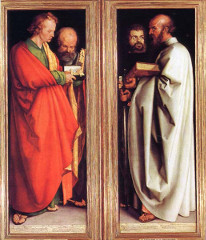 Apostolic succession has had three different meanings in the history of the church.1
Apostolic succession has had three different meanings in the history of the church.1
(a) In the second century, apostolic succession was important (over against gnosticism) because of the issue of historical continuity. A historical succession of bishops was one of the four marks distinguishing catholic Christians from their gnostic opponents. Those churches that recognized the canonical authority of Scripture, interpreted and summarized Scripture by the Rule of Faith, and worshiped in word and Sacrament were the same churches that could trace their history through a succession of bishops from the apostles. This is the argument used by Irenaeus in Against Heresies 3.3,4. The focus here is on succession of bishops as an assurance of orthodox teaching.
(b) The bishops are successors of apostles in the sense that they continue to exercise various functions exercised by the apostles: teaching, preaching, celebrating the sacraments, ordination.
(c) The most controversial understanding of apostolic succession is that the “grace” of ordination is handed down from the apostles from one generation of bishops to another through the laying on of hands.
The reason that (c) is controversial is because of the questions it raises concerning the validity of ordination in those churches that do not have episcopal polity or who cannot trace their ministry through the historical succession of bishops. For those who hold to (c), the validity of the orders of non-episcopal Reformation churches have been called into question:
(1) Apostolic succession was strongly affirmed in the Oxford Movement. However, (a) and (b) were not distinguished from (c), with the result that there were either concerns about the validity of sacraments in non-episcopal churches or it was simply assumed that there were no valid sacraments in non-episcopal churches.2
(2) Pope Leo XIII’s bull Apostolicae Curae (1896) notoriously declared Anglican orders to be “absolutely null and void,” to which the Archbishops of York and Canterbury responded with Saepius Officio (1897); the question of the validity of Anglican orders continues to be a major point of contention between Roman Catholics and Anglicans. Cardinal Joseph Ratzinger’s (later Pope Benedict XVI) commentary on Ad Tuendam Fidem in 1998 stated that the teaching of Apostolicae Curae concerning the invalidity of Anglican orders is one of the teachings to which Roman Catholics must give “firm and definitive assent.”
(3) The Chicago-Lambeth Quadrilateral stipulated that “The Historic Episcopate, locally adapted in the methods of its administration to the varying needs of the nations and peoples called of God into the unity of His Church” is one of four conditions necessary for church union with Anglicans.
(4) When the Church of South India was formed by a union of Anglican and non-Anglican churches, those with non-Episcopal ordinations were not required to be re-ordained, although all future ordinations included bishops. Although the Lambeth Conference approved of the formation of the Church of South India, my understanding is that its membership was temporarily suspended from the Anglican Communion until the status of episcopal ordinations was normalized.
(5) In ecumenical agreements leading to intercommunion between Anglicans and non-episcopal churches (such as the Lutheran), agreements have taken place by which future ordinands receive episcopal ordinations.
In The Doctrine of the Church and Christian Reunion (1920), A. C. Headlam argued that there is early historical evidence for (a) and (b), but that they should not be confused with (c), which is late, and does not appear until the time of Augustine of Hippo, and there is no evidence for (c) in the early church. Modern discussions of apostolic succession confuse (c) with (a) and (b), and then read into references to “apostolic succession” in the church fathers an understanding of the transmission of grace through episcopal succession that they did not have. Headlam argued that there is a significant difference between apostolic succession in senses (a) and (b) and (c): Concerning (a), he writes: “[T]here is no idea that the validity of [the bishop’s] ordination depended upon this succession, or that the succession depended on any spiritual gifts received at ordination.” Concerning (b), he writes: “[W]hat is definitely maintained is that for a valid ministry and the due performance of the Sacraments this succession and transmission by ordination is necessary.” Finally, concerning (c), Headlam states: “I have, I think, read everything from the Fathers which is quoted in favour of the Apostolic Succession, and I do not know any passage which speaks of succession by ordination in this sense.”3
Headlam argues that in the early church, the doctrine of orders was as follows:
(1) The ordination is performed in the church, where the Spirit is present, and the power to give the gifts of the Spirit comes through the church.
(2) The rite is performed the way that the church has ordained, understood as having passed down from the apostles.
(3) The rite is performed by the duly appointed minister who had received the authority to do so, i.e., the bishop. However, this is not because of a spiritual power received by transmission from the apostles, but because the church had consecrated him with the authority to do so.
(4) The theology behind this is that the work of the Church is the work of God and that God gives the Spirit in answer to the prayers of the church. The essential matter of ordination is prayer accompanied by the laying on of hands.
Against Headlam, Michael Ramsey argued that (c) is implicit in (a) and (b). Ramsey argued for (c) on the basis of Christ’s acting in the liturgy. If Christ acts through the bishop, then (c) is true. Grace is bestowed by the risen Christ through the action of the whole Church. Since Christ bestows grace through the sacramental actions of his body, and since certain actions of grace are confined to the bishop, i.e., ordination, then “the Church’s full and continuous line of grace does depend on the succession of Bishops, whose work, however, is not isolated but bound up with the whole Body.”4
Ramsey’s point, while true, does not really address Headlam’s criticism of (c), and so his conclusion does not follow. That Christ acts through (a) and (b) may imply that Christ acts through bishops, but it does not imply (c) that ordination takes place through a transmission of grace that is passed down exclusively through the laying on of hands of bishops in apostolic succession, or the converse, that Christ does not act in churches that do not have such bishops. Headlam’s argument is that the early church saw ordination as a gift of the entire church who delegated the authority of the laying on of hands to bishops ordained in the apostolic succession. The alternative position sees ordination as a gift attached specifically to bishops in apostolic succession which they exercise on behalf of the church. Both are arguments for apostolic succession, but they understand its significance in different ways and the two views have very different consequences when addressing the status of churches that do not have bishops ordained in apostolic succession.
In light of the above, it is important to remember that historic Anglicanism did not consider episcopacy to be of the esse of the church, but of the bene esse. Both John Jewel in his Apology of the Church of England and Richard Hooker in The Laws of Ecclesiastical Polity considered episcopacy to be an indication that the Church of England was in continuity with the catholic church (especially of the patristic era), but did not claim that the non-episcopal churches of the continental Reformation were not true churches or were lacking in means of grace. William Palmer’s “three branch theory,” formulated in his Treatise on the Church of Christ (1838) marks a shift from the historic Anglican position in this regard.
1 Michael Ramsey, The Gospel and the Catholic Church (London: Longmans, Green: 1956), 82; Arthur C. Headlam, The Doctrine of the Church and Church Reunion (NY: Longmans, Green, 1920), 124-133.
2 “Why should we talk so much of an establishment, and so little of an APOSTOLICAL SUCCESSION? Why should we not seriously endeavour to impress our people with this plain truth;–that by separating themselves from our communion, they separate themselves not only from a decent, orderly, useful society, but from THE ONLY CHURCH IN THIS REALM WHICH HAS A RIGHT TO BE QUITE SURE THAT SHE HAS THE LORD’S BODY TO GIVE TO HIS PEOPLE?” John Keble, “Adherence to the Apostolical Succession the Safest Course,” Tracts for the Times, Tract 4.
3 Headlam, 124-133.
4 Ramsey, 83.


